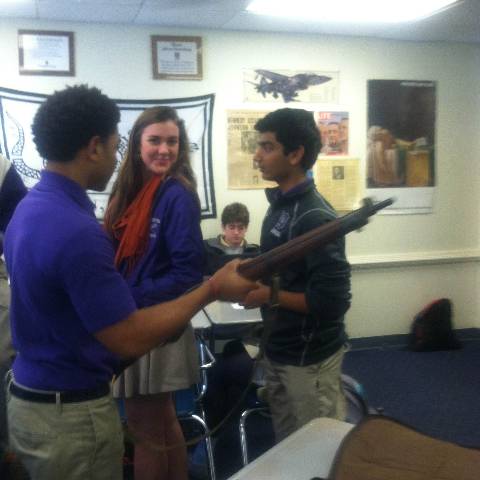

As of 2012, there are no living World War I veterans. The first global war, which left the world “shell shocked,” no longer lives in the minds of anyone anywhere. To many of my sophomore students, World War I is just a stepping stone to what they’re really excited to learn about this semester — World War II. But to understand World War II, we need to truly understand the global ramifications of its predecessor.
World War I marks the advent of new military technology (tanks, airplanes, submarines, barbed wire, mustard gas, etc.), and the deadly crux between modern industrial technology and ancient war tactics. The enormous casualties on both sides were a testament to the brave men who climbed over their trenches to run across “No Man’s Land” — an area fully exposed to the deadly fire and poisonous gas from these new weapons.
How to bring this historic event to life?
To simulate the experience of a World War I soldier, we lined our desks into two opposing lines, crawled underneath, and figured out our next move. With our legs cramped and our necks craned, we plotted what to do in different scenarios. When Evan Gober and Brian Kim “died” in their trenches, their trench-mates figured out how to remove their bodies. Two students dragged them out from under their desks, and placed them in “No Man’s Land” (a clumped area of desks in the middle of the classroom), all while at the risk of exposure to enemy fire. When a “rat” nibbled Kush Patel and Nina Zhou’s bread, they had to decide if they would still eat it and risk contracting dysentery. When Kattie Li “ate” a bad tin of canned ham, she plotted how to best relieve herself while in such close proximity to her trench-mates.
However, to properly simulate this effect, we needed the actual technology used by the soldiers. Last summer, I purchased a gas mask from a vendor at a flea market in New Milford, Conn. The mask dates to the 1950s, but the filter dates to the 1970s. Although it is clearly not a World War I era mask, the effect of putting on the mask is the same. Mamie Johnson was surprised at how heavy the gas mask felt on her face, and noted that this would feel “irritating” after a while.
With the school’s permission, Mrs. Braden transported Evan Gober’s grandfather’s Lee-Enfield rifle to school. Although Evan’s grandfather used this rifle during his service in the Korean War, the British used this same model in World War I. Evan explained to the class how to load and clean the rifle, and students took turns handling the [unloaded] weapon. After passing the Lee-Enfield around, like the gas mask, students were surprised at its weight. Fifi Tran wondered how they held these rifles upright for so long.
Afterward, groups of four constructed propaganda posters. Using the five tools of propaganda — demonization, name-calling, catchy slogans, patriotic symbols, and appeal to fear — students came up with a message to garner “total” support from the nation they represented.
Jack Talley, Mamie, Evan and Kattie chose to represent Austria-Hungary and depict the event that sparked the war. Their poster showed the assassination of Austria-Hungary’s archduke, and attempted to boost morale inside the Austro-Hungarian Empire. The poster reads: “If you want the Archduke to rest in peace, do not let the fighting cease.”
Julian Porto, Avery Smith, Sunde Armstrong and Kush represented one of the Allied Powers, and chose to recruit soldiers through demonization—making their enemy appear evil. Their poster depicted a German solider attacking young children with the slogan: “Stop this man, save the land.”
Sara Berry, Georgi McCauley, Madison Vaughn and Fifi chose to represent the United States. The goal of their poster was to recruit soldiers using the tools of demonization, name-calling, and appeal to fear — they drew a German soldier (dressed up as a giant-sized fool) capturing an American soldier: “Protect us from this fool, join the war duel.”
Caroline Schoen, Lisa Van Susteren, Donna Ren and Thompson Liu represented Germany and used the appeal to fear tactic to recruit soldiers. Their poster shows a British tank pointing at the viewer, implying that if German men don’t enlist, they will die at the hands of the British. The group wrote their slogan in German. Translated, the slogan reads: “Your fatherland is in danger. Help us, don’t be a stranger.”
JC Wang, Mohammed Al-Asfour, Nina and Brian wanted to inspire patriotic sentiment in the citizens of Great Britain. Their poster reveals a soldier cloaked in the flag of the United Kingdom. The soldier is stabbing the German flag with the words “Stab the Flag” above.
Maksud Dzhabrailov, Sam Kim, Ted Fei and Ryuji Kano represented Germany, and pleaded with the German people for monetary aid — they needed gas masks for their soldiers. Their slogan reads: “No wealth, no health.”